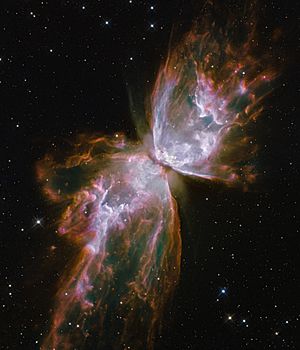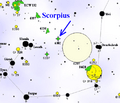NGC 6302 facts for kids

NGC 6302, also known as the Bug Nebula or the Butterfly Nebula, is a beautiful cloud of gas and dust in space. It is a type of object called a planetary nebula. You can find it in the constellation of Scorpius, which looks like a scorpion in the night sky. This nebula is very far away from Earth, about 3,400 light-years from us.
Contents
What is NGC 6302?
NGC 6302 is a special kind of space cloud called a planetary nebula. Don't let the name confuse you, though! It has nothing to do with planets. Early astronomers thought these objects looked like planets through their telescopes, so the name stuck.
What is a Planetary Nebula?
A planetary nebula is actually the outer layers of a star that has reached the end of its life. Imagine a star like our Sun. When it gets very old, it runs out of fuel. It then swells up into a huge, cool star called a red giant. After this, it sheds its outer layers of gas and dust into space. This creates a colorful, expanding cloud around the star's core.
How Nebulae Form
When a star like the Sun runs out of hydrogen fuel, it starts to burn helium. This makes the star expand greatly and become a red giant. Eventually, the star becomes unstable and blows off its outer layers. These layers form the beautiful nebula we see. The hot, dense core of the star, called a white dwarf, is left behind in the center. This white dwarf shines brightly and makes the gas in the nebula glow.
The Bug Nebula's Special Features
The Bug Nebula is famous for its unique and complex shape, which looks a bit like a butterfly or a bug. This shape is created by the way the star inside blew off its gas.
Its Hot Star
At the very center of the Bug Nebula is a very hot star. This star is a white dwarf, and it's one of the hottest known stars in our galaxy. Its temperature is around 220,000 degrees Celsius (about 400,000 degrees Fahrenheit)! This extreme heat makes the surrounding gas glow brightly in different colors.
Its Unique Shape
The butterfly shape of the Bug Nebula is quite unusual. Scientists think this shape might be because the dying star had a companion star nearby. The gravity of the second star could have pulled the gas into these two distinct lobes, or "wings." Another idea is that the star might have had a very fast wind of gas coming from its poles, shaping the nebula. The nebula also has a dark, dusty "waist" that hides the central star from our view.
Where to Find It
The Bug Nebula is located in the constellation Scorpius. Scorpius is a bright constellation that is easy to spot in the night sky, especially during summer in the Northern Hemisphere or winter in the Southern Hemisphere. It is near the center of our Milky Way galaxy.
Images for kids
See also
 In Spanish: NGC 6302 para niños
In Spanish: NGC 6302 para niños


